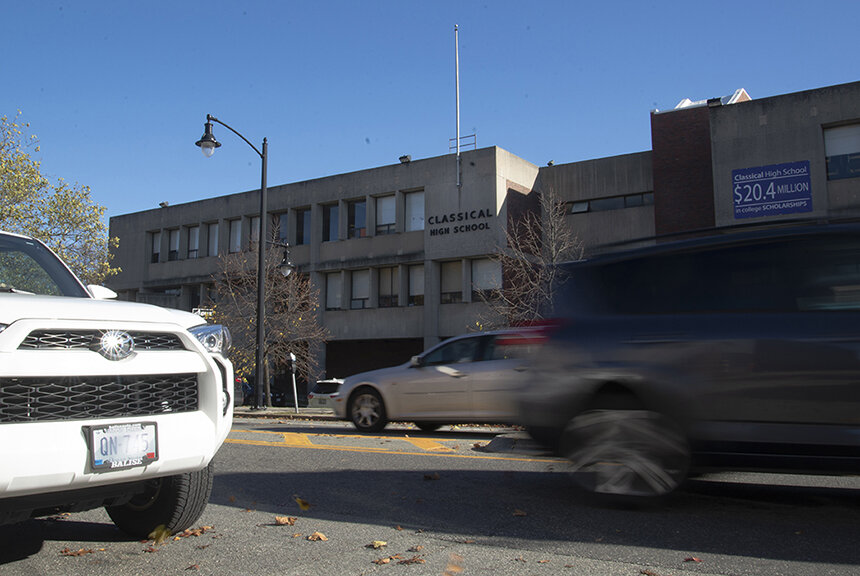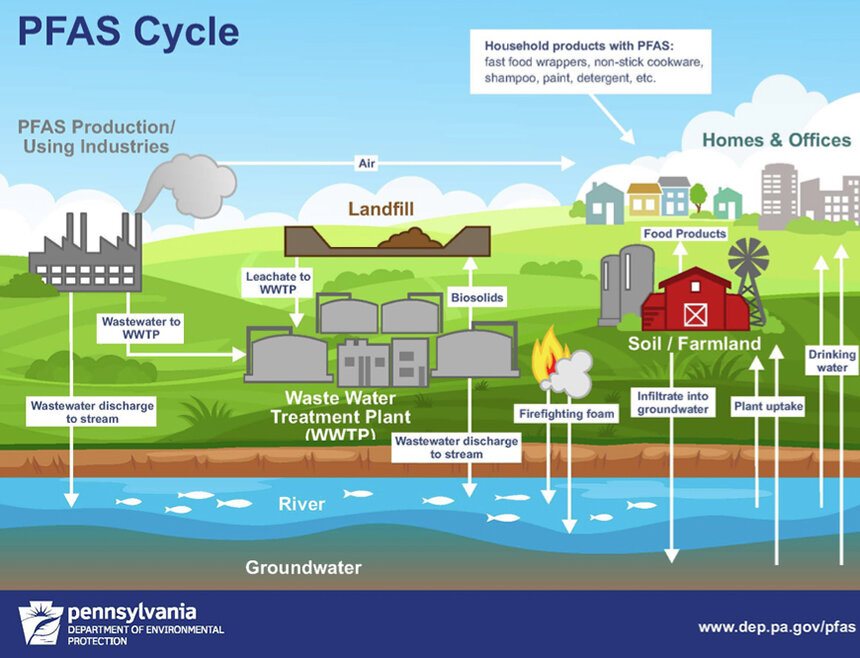Intersection of Schools and Highways Produces Bad Air
Providence has 24 schools within 1,000 feet of major roads, and that’s contributing to a childhood asthma crisis
November 3, 2019
PROVIDENCE — The Vartan Gregorian Elementary School sits at the intersection of Wickenden and East streets. It’s close to a cafe, a doughnut shop, India Point Park, residences, and the bustle of city life. Behind it is Interstate 195, and close by is Interstate 95.
“It’s at the intersection of two highways. That’s really quite close,” said Gregory Wellenius, director of the Center for Environmental Health and Technology at Brown University. “The last time I looked at the building, the areas where the kids play and have recess, those are actually right adjacent to the highway.”
According to the Center for Public Integrity’s data visualization map of school proximity to highways, the interstate nearest Vartan Gregorian is used by more than 30,000 cars daily.
That’s a lot of pollution passing by the windows of the elementary school. The vehicles of today, be it a Prius or a Ford F-150, aren’t nearly as clean as we may think.
These vehicles spew a cocktail of particulate matter (such as soot, which is less than a tenth the width of a human hair), volatile organic compounds (which are often carcinogenic and contribute to increased ozone), carbon monoxide, and sulfur dioxide, among other pollutants.
These contaminants are linked to a slew of childhood development issues, ranging from stunted lung growth and worsened asthma symptoms to increased risk of heart disease and cancer to learning disabilities.
“Kids are more vulnerable to air pollution because they tend to spend a lot more time outside than adults. They also breathe much faster,” Wellenius said. “So the impacts of those pollutants can be more pronounced because their lungs are rapidly developing. There’s a lot of evidence that kids being exposed to these high levels of air pollution are having effects on their lung growth. There’s a greater risk of developing asthma, or of asthma worsening.”
Rhode Island’s childhood asthma rates are among the highest in the country, a whopping 11 percent. And Vartan Gregorian isn’t the only school right off a major road(s).
Providence alone has 24 schools within 1,000 feet of major roads, including three schools for students with special needs. About 8,000 public schools nationwide lie within 500 feet of highways, truck routes, and other roads with significant traffic, according to a joint investigation by the Center for Public Integrity and Reveal from The Center for Investigative Reporting.
Classical High School is on Westminster Street and a few hundred feet from I-95. With the traffic of these two roads combined, the students there are exposed to the pollution from at least 40,000 cars and 500 trucks every day.
“If you put a school right near a highway, there’s going to be a lot more exposure to pollutants than if that school was farther away,” Wellenius said. “And we’ve seen that within the first 250 meters (820 feet) of a major roadway, there’s substantially elevated pollutants from that traffic. So we really should be building schools at least 500 meters (1,640 feet) away from highways.”
For Bill Mott, executive director of the Providence-based Ocean Project and parent to children who attended Vartan Gregorian, this situation is unacceptable.
“After I found out that the school is perched right on the edge of the interstate, I started looking into the literature and saw that best research done is in Southern California,” Mott recalled. “Long Beach had a huge air-quality issue, which caused a huge asthma crisis there. So I looked into it, and found out that in California they don’t allow schools to be built anywhere near interstate highways.”
In 2003, California banned schools from being built within 500 feet of a highway.
Rhode Island technically has restrictions on where schools can be built, with the Rhode Island Department of Education’s School Building Authority construction regulations stating that project sites must have a minimum separation of 1,500 feet “from railroad tracks, hazardous pipelines, and major highways.”
There’s one major problem, however: This relatively new construction clause doesn’t take into account schools that are already built, many of which are well within 1,500 feet of major highways and roads.
In 2011, Mott saw this problem firsthand, when he teamed up with Shae Selix, a senior at Brown University, and Meredith Hastings, an associate professor of environment and society, to conduct research into the pollution levels near the Vartan Gregorian Elementary School.
What they found was disturbing.
In Selix’s thesis, he reported finding elevated levels of nitrogen dioxide both outside and inside Vartan Gregorian, and the 24-hour outdoor averages were more than seven times higher than the Environmental Protection Agency’s yearly average for Providence in 2011.
Their research also found high amounts of black carbon which, according to the EPA, is associated with respiratory and cardiovascular disease, cancer, and birth defects.
“They did find black carbon in testing and that led to shutting down the youngest children’s playground, which was immediately near the highway,” Mott said. “The older kids’ playground is farthest away from highway, which is definitely better, and they planted trees to try and block particulate matter. But that’s a Band-Aid approach, and was really just a way to raise awareness to help parents, teachers, and administrators realize there is an issue here.”
Mott helped secure two advanced air-filtration systems from IQ Air, a Swiss-based company whose products were used by the U.S. track and field team when it participated in the Beijing Olympics. After installing the systems at Vartan Gregorian, Selix’s report found that the average black carbon level inside classrooms was more than 80 percent lower than the outdoor average.
But those air-filtration systems were installed years ago. Mott is concerned that these systems aren’t being used properly now, since new filters cost hundreds of dollars.
“While the machines are great, the filters cost a lot of money,” he said. “And it’s no good if you don’t change them regularly.”
Vartan Gregorian principal Matthew Russo, who began the job this year, was contacted by ecoRI News about the status of the school’s two air purifiers. He said he was unaware of their existence.

Mitigating the problem
While existing schools seem to have little regulation when it comes to air-quality problems caused by nearby roadways, new schools under construction or old ones being renovated do have potential for including improved air-filtration systems. New schools also, by state law, can’t be built within 1,500 feet of a major highway, such as I-95 or I-195.
Even before the damning report on the sorry state of Providence’s pubic schools by a team from John Hopkins University was released in June, city schools and other public school districts have been scrambling to fix a system that has a fat, red F written across it.
However, there has been some success.
In 2018, Rhode Island voters approved a $250 million statewide school construction bond, which in turn activated six new temporary bonus incentives. The state’s School Building Authority oversees this program, and a few districts, Barrington and East Providence, have already broken ground — and in Barrington’s case, completed work — on new buildings that include better ventilation systems.
According to a Rhode Island Department of Education 2017 action plan, school projects in Rhode Island must comply with all the requirements set forth in the most recent Northeast Collaborative for High Performance Schools.
One of these requirements from the collaborative’s latest version is: “Delivers 100% fresh outdoor air directly into each space without first mixing it with any recirculated building air.”
The new Barrington middle school was built with a displacement ventilation system. Dom Puniello, a project manager on the building team, said, “It’s like we take the old approach of supplying air from the ceiling and turn that around. Now we supply it from the floor, and we displace it from the ceiling. Why not get the bad air out at the top, and bring the good air towards the bottom where people are.”
While this system provides clean, cool air, Puniello doesn’t believe it’s a system that can be installed in existing schools.
“It would be nearly impossible, extremely difficult at best” he said. “A lot of the older schools have a low floor-to-ceiling height, and instead of displacing the air it would kind of create a mixed-air system, which is what old schools already have.”
When School Building Authority chief executive officer Christine Lopes Metcalfe was asked about this, she said, “The indoor air-quality requirements include high levels of filtration to be integrated into HVAC [heating, ventilation, and air conditioning] systems, as well as pollutant source control, moisture management, construction, and post-construction indoor air-quality management, and other aspects that impact student and staff health.”
She noted that the state will provide funding to projects that integrate these standards into their buildings’ systems. The state, however, will not provide funding for standalone equipment such as an air purifier, she said.
Schools such as Vartan Gregorian, instead of getting funding for an interim solution to air-quality concerns while money is raised to build a new school, are forced to live in these antiquated mixed-air atmospheres, or raise the money themselves for a short-term solution.
But an interim solution could be as simple as a high-efficiency particulate air (HEPA) filter system, according to Wellenius.
“Many of the homes in New England have forced hot air heating and air conditioning, and you can put a HEPA filter on them and that actually reduces pollution inside your house quite a bit, and the same goes for schools,” he said. “Most schools in New England don’t have active ventilation, most often they have windows and sometimes those windows have been sealed shut so that you have no air circulation or ventilation. In those cases, the pollutants inside can build up to higher levels than the outdoor pollutants.”




In Providence, our capital city, I95 needs to be decked over. It is a no-brainer. The decking does not need to be load bearing, the space can be used for green space, public gardens, and recreation. The improvement in air quality and noise dampening would be greater than any other area of the state. It would also connect the West Side and Federal Hill back to Providence and make the neighborhoods more walkable. Cianci proposed this at some point, as the Westminster Crossings project (I believe). It is a no-brainer.